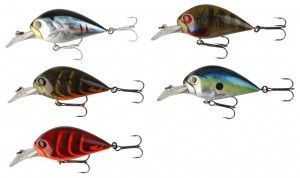The oversized denizen of the deep stalked the battered yellow and red chugger with the intensity of a cat worrying a mouse. A momentary pause followed by two quick gurgles triggered a simultaneous explosion and crash dive doubled the rod over into a U and turned the reel spool like a buzz saw. Surface baits add an extra dimension to fishing, because you see the strike. Noise of the correct frequency and intensity rings the dinner bell for predators, while too much noise can have a negative effect.
An injured or distressed fish tends to struggle on or near the surface and it sends out vibrations that toll in the bigger guys. That’s why hooked bait in a school will be singled out and struck. The amount of noise or commotion a lure generates makes a difference. More subtle gurgles produce far better than loud pops in shallow water, while louder pops in deep water will excite predators from the depths or a greater distance. That’s because fish tend to be much more alert to noise in the shallows, since they usually don’t have the security of structure and they can’t rely on depth.
Topwater baits come in a staggering array of colors, sizes, shapes, styles, and designs. The key lies in picking a selection that works for you and stick to it. The better you become at fishing a handful of lures, the more fish you will catch. For me, the essentials include chuggers, stick baits, minnow types, and darters. The weight of the lure should match the tackle you are using with a few smaller baits and a handful of larger ones tossed in.
A surface lure when viewed from below appears as a silhouette against the sky. Darker colors tend to produce better during periods of low visibility (early and late in the day). When you change color, think in terms of dark and light. If you are fishing a darker bait and you’re not getting strikes, make a dramatic change to a light colored one or vice versa.
The actual retrieve depends on the type of lure, water depth, the species you seek, water temperature (fish are more sluggish in colder water), and conditions in general. The best way to learn to work a lure centers on short casts where you can monitor rod movement and retrieve speed. If a fish follows a lure, try speeding it up or work on some erratic movements to motivate the predator into striking.
After dark, the most effective lures produce a constant source of sound rather than periodic pops. They should be retrieved continuously so that the gamefish can home in on the lure. Stick baits and minnow type plugs work best under these conditions.
Minnow plugs come factory equipped with a lip designed to take it to a pre-determined depth. Most of them will float back to the surface if you pause the retrieve and that sometimes can be the trigger mechanism to elicit a strike. Don’t be afraid to modify the lip to make it run shallower or remove the lip entirely to keep it just under the surface.
Topwater fishing takes concentration, because you have to make the lure look alive and in trouble. You’ll know when you do it right and never forget those explosive strikes. It’s fun, try it!
[easy-social-share]
